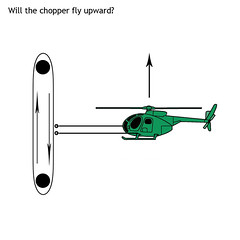HAHAHAHAHA! A Pilot! Condescending and Wrong.
The trick is that the treadmill cannot prevent motion relative to the ground (and air) unless the A/C is teathered. The question doesn't state it is teathered to the treadmill--if the treadmill were long enough, the plan would certainly take off.
Unlike motorcycles, airplanes don't use their wheels to gain velocity and the treadmill cannot prevent you from gaining airspeed.
************************

when you decide to mock someone, make sure your argument makes sense so you don't look even more the fool.
1. "The trick is that the treadmill cannot prevent motion relative to the ground ..." WHAT ARE YOU TALKING ABOUT?? the treadmill *IS* the ground!! The plane is SITTING ON THE TREADMILL!!

2. "Unlike motorcycles, airplanes don't use their wheels to gain velocity..." WHAT??? How the hell does an airplane gain velocity to achieve take off speed??? On the ground, its by use of wheels...on water, its by pontoons or boat belly! Imagine an airplane, lets say a Cessna 152 for example. Take off its wheels, and it will not take off! Thrust has to overcome drag in order for it to fly. Lift has to overcome weight in order for it to sustain flight. What you probably meant to say was that unlike a motorcycle, the wheels are NOT powered. This is true, but the thrust from an airplane (generally speaking) is not great enough to pull the weight along the ground fast enough to achieve take off speed without help from wheels/skids/etc.
So, lets analyze the scenario. The Cessna 150 is put on a treadmill. The treadmill can either be powered or free wheeling (kinda like a dyno for a bike). The Cessna is powered up...the pilot has his brakes on, so the plane and the treadmill do not move at all. He releases the brakes, engine at 1000 rpm (idle)...the plane starts to roll forward, but the treadmill moves rearward at exaclty the same speed as the wheels, so the plane does not move relative to you standing there watching. Now, although the wheels on the plane are not gear driven, the prop pulling air will cause the mass of the plane to move forward, thus the treadmill moves rearward. Net movement relative to you is zilch. Remember, the plane has WEIGHT, so it is VERY much attached to the treadmill(ground). Until the plane achieves enough forward motion to have mandatory air speed for liftoff, it WILL remain heavy on the wheels, which WILL drive the wheels, which WILL move the treadmill. As the pilot continues to apply power, the plane continues to be thrust forward, and of course, the treadmill continues to move rearward. Again, there is ZERO wind moving across the wings (cept for prop blast), so it cant lift off, but it WILL continue to roll forward on the "ground", which causes the "ground" (treadmill) to quicken its rearward movement. We can keep this up all day long, throttle firewalled, and the damn treadmill will continue to match the "speed" of the takeoff roll to the point that the plane never achieves its rotation speed to take off, since there is NO airspeed.
If you really dont think that the wheels have anything to do with the plane taking off, think about this. Have you ever seen a big jet airliner that has gone off the runway, and is stuck in mud or snow? You can give it throttle, but I be damn if the sunny beach flys off the ground! Cause the damn wheels are STUCK!! The jet is pushing the air, but that dont mean squat if the wheels cant move!
The same thing would happen to a boat if you made a "water treadmill" that could be controlled so that the current would run opposite the thrust of the boats prop...you would give the boat full throttle, and the current of water would increase to match the thrust, and the boat would just SIT THERE with no relative movement to the beach.
The ONLY way a plane could take off from a treadmill in calm air would be if somehow it could move forward to take off speed before the treadmill was active. In the case of the Cessna 150 , you would have to achieve a forward speed of 55mph or more to get the air flow over the wings enough to cause lift!
Jay
'04 FJR 1300 :dribble:




















































